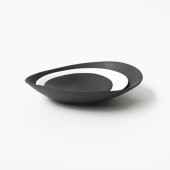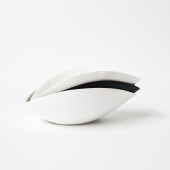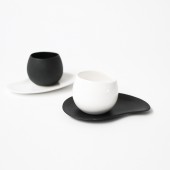DESIGN NAME:
Water Droplet
PRIMARY FUNCTION:
Coffee Set
INSPIRATION:
The work 'Water Droplet' takes inspiration from water droplets, with each vessel born from water and integrated with it. Although not an overt depiction of water droplets, it allows viewers to experience the dynamism of water. It seems as though round water droplets are placed right before one's eyes, and the smooth shape transmits a gentle and comfortable feeling during use.
UNIQUE PROPERTIES / PROJECT DESCRIPTION:
'The harmony of water and fire, united by earth' - ceramics, a product of water, fire, and earth, relies heavily on water during its production and use. Water makes ceramics mellow, while ceramics make water lively. The work includes a coffee pot, coffee cups, saucers, and a fruit plate. The design of the work takes water as its source and showcases its different forms, including roundness, fullness, and flow.
OPERATION / FLOW / INTERACTION:
The work provides users with more practical coffee utensils. The curved handle offers a better grip, and the support point created by the handle and the table enhances the stability of the coffee pot. The lid design eliminates a protruding knob and uses an inward-curved arc to maintain the integrity of the water droplet shape of the coffee pot to the maximum extent. The saucers and fruit plate also add richer functional experiences to the coffee time.
PROJECT DURATION AND LOCATION:
This work finished in 2020 in Nanjing, China
|
PRODUCTION / REALIZATION TECHNOLOGY:
3D printing resin model, Plaster mold casting slip, porcelain clay fire to 1250℃
SPECIFICATIONS / TECHNICAL PROPERTIES:
Jug: 122mm x 150mm x 125mm
Cup1: 74mm x 74mm x 62mm
Cup set: 120mm x 90mm x 13mm
Plate1: 237mm x 200mm x 82mm
Plate2: 237mm x 175mm x 82mm
Plate3: 237mm x 140mm x 82mm
Dish1: 177mm x 181mm x 50mm
Dish2: 150mm x 138mm x 40mm
Dish3: 95mm x 70mm x 11mm
TAGS:
Ceramic design, coffee set, bionic design, 3D technology, ceramic ware
RESEARCH ABSTRACT:
Research type: Ceramic product design; Research objective: To provide better service vessels for daily life using ceramics as the material; Research method: Combining the art and science of industrial design, imitating the external forms and symbolic meanings of biological organisms and natural materials, and applying them to design through appropriate artistic processing techniques. From a humanistic perspective, the research pursues a diverse design integration and innovation that embodies the dialectical and materialist symbiotic aesthetic concept, not only in material aspects but also in spiritual aspects, between tradition and modernity, nature and humanity, individuality and the masses.
CHALLENGE:
The main problems addressed by this design are: firstly, how to integrate the form of water into the design of the utensil, expressing the natural fluidity of water while fulfilling its practical functions. The solution lies in the use of different forms of water in the design of different utensils to achieve the integration of form and function. Secondly, how to achieve a good combination of ceramic and metal materials. The smooth ceramic glaze and the metal are prone to detachment during adhesion. To address this, a non-glazed treatment is applied to the adhesion area during production to increase the friction between the ceramic and the metal.
ADDED DATE:
2023-03-28 04:19:05
TEAM MEMBERS (1) :
IMAGE CREDITS:
Xin Wang, 2022.
|










